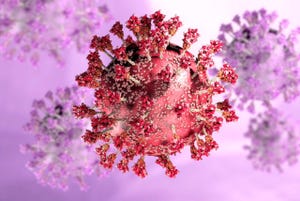Wearable Blood Filter May Be Emergency Dialysis Stand-In
March 10, 2014
|
SEM image of zeolite-EVOH nanofiber composite (scale bar: 8 ?m). (Courtesy Namekawa et al.) |
Envisioning a simple, cheap, and accessible way to treat patients suffering from kidney failure in places where dialysis isn't available, a team of researchers from the National Institute for Materials Science (NIMS) in Ibaraki, Japan, has developed a nanofiber mesh that can remove toxins and waste from blood.
In their paper, "Fabrication of zeolite-polymer composite nanofibers for removal of uremic toxins from kidney failure patients" (Namekawa et al.) published in Biomaterials Science, the researchers describe their work in creating a self-contained wrist-wearable device suited for use in areas with missing or damaged dialysis infrastructure, such as third-world countries or disaster areas.
The research team, led by Mitsuhiro Ebara of the International Center for Materials Nanoarchitectonics, NIMS, fabricated a nanofiber mesh made of a blood-compatible ethylene vinyl alcohol polymer (EVOH) matrix. This matrix holds aluminosilicate zeolite particles, which have microporous structures capable of adsorbing uremic toxins such as creatinine from blood.
The mesh was generated using cost-effective process called electrospinning. This process uses an electrical charge to draw fibers from a liquid. In this case, the zeolite dust (average particle size approximately 2-3 ?m) was mixed with the EVOH electrospinning solution and ultrasonicated for 1 hour.
In their experiments with various zeolite compounds, Ebara and his team found that the silicon-aluminum ratio within the zeolite is critical to creatinine adsorption. The researchers noted that beta type 940-HOA zeolite had the highest capacity for toxin adsorption, so that compound was used in their project.
Find out more about the medical device industry--including its technology, supplier networks, and much more--at BIOMEDevice, March 26-27, 2014 in Boston. |
Scanning electron microscope (SEM) images of the finished mesh revealed that the EVOH solution produced nonwoven fibers with continuous and smooth morphology. The SEM also showed that over 90% of zeolites in the solution were successfully incorporated into the EVOH nanofibers.
Although the scientists say that the barrier properties of the EVOH matrix lowered the creatinine adsorption capacity of the zeolites in the fiber when compared with adsorption capacity of free zeolites, they were still able to achieve 67% of the adsorption capacity of free zeolites.
The researchers say that their system as presently constituted would require about 170 g, or 10 cm3of their current nanofiber mesh material to last for one day. They feel that this is too large a volume, and are working to increase the effective surface area of the zeolites within the mesh so as to lower the necessary volume of material.
Stephen Levy is a contributor to Qmed and MPMN.
About the Author(s)
You May Also Like



